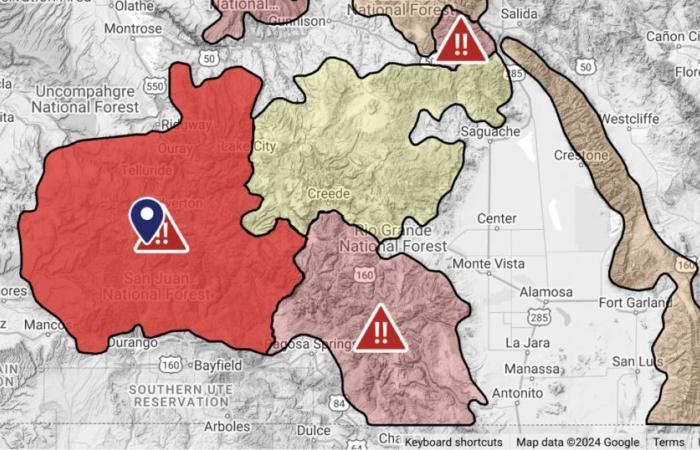The ski season is off to a strong start after recent storms, and Telluride Ski Resort opens for the season on Thanksgiving, Nov. 28. But for people looking to celebrate the holidays and the fresh powder in the backcountry, avalanche danger has also shot up alongside the snow accumulation.
The Colorado Avalanche Information Center (CAIC) issued an avalanche warning on Tuesday evening, which remains in effect. The heavy snow and strong winds create conditions where backcountry travelers have a high likelihood of triggering “large and dangerous” avalanches. Other avalanches will also release naturally.
Although the predicted bluebird skies and fresh early season conditions could be tempting, CAIC warned against “powder fever” preventing good backcountry decision-making. In their forecast, CAIC noted that “travel in avalanche terrain is not recommended during this time period.”
On Thanksgiving Day, CAIC forecasts avalanche danger as “high” (4/5) above and near treeline in the western San Juan mountains. Avalanche risk is “considerable” (3/5) below treeline. On Friday, avalanche risk lowers slightly to “considerable” across all elevations.
“Avalanche conditions in the southern mountains will change dramatically this week,” CAIC public information officer Kelsy Been told the Daily Planet. “The multi-day winter storm that started Tuesday will deliver over two inches of water, or 20 plus inches of snow by Thursday in parts of the southern mountains, including around the Telluride area.”
Because snow piled up so quickly in this storm cycle, it formed a cohesive slab of snow, which sits on top of multiple weak snow surfaces that formed in the dry weather of the past two weeks. Steep slopes with new snow and wind drifts are especially vulnerable to avalanches. North and east-facing slopes present the most avalanche risk, where new snow and westerly winds have created thick cohesive slabs. The conditions make avalanches very likely, and CAIC forecasts a natural cycle of avalanches large enough to bury people. Any avalanches that release from the new snow could break widely and cut into older, weaker snow, spreading into a bigger avalanche event.
“This new snow will increase the avalanche danger, making large, destructive avalanches likely by Thanksgiving,” Been said.
If people observe shooting cracks, or feel rumbling or collapsing snow, they should avoid heading across or underneath slopes steeper than 30 degrees in that zone.
With the new snow accumulation, mountain conditions will evolve quickly, and backcountry users must be able to adapt as well and exercise caution in the coming days.
“Backcountry travelers should prepare for rapidly changing conditions,” Been said.
Even avalanches on small slopes could turn dangerous if there are terrain traps around. A small amount of avalanche debris can stack up if it pushes backcountry travelers into gullies, thick trees or flat runouts, like roads.
Looking forward, after Thanksgiving Day, the San Juans are likely to see a longer period of dry weather going into mid-December.
“The pre-Thanksgiving storm cycle brought snow totals of one to three feet to the San Juan mountains. The atmosphere has a funny way of balancing itself out, though, as we have essentially zero chance for snow through at least the first week of December. We’ll likely have to wait until the middle of December for snow and stronger storms to return,” OpenSnow meteorologist Sam Collentine told the Daily Planet.
Avalanche danger is forecasted to stay elevated throughout Thanksgiving weekend. CAIC recommends that backcountry travelers check the avalanche forecast regularly and change their plans if needed. Always bring proper avalanche safety gear, including a beacon, probe and shovel. For the latest avalanche conditions, visit Colorado.gov/avalanche.






